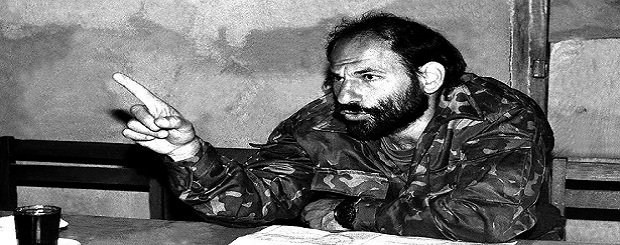
NATIONAL HERO MONTE MELKONIAN – MONTE – “SPECIALIST OF ARCHEOLOGY AND ASIAN HISTORY” – Karine Avetisyan
DECEMBER 12, 2021 – COUNTRY – HISTORY – CULTURE.
Karine Avetisyan – IN THE ARMENIAN MOUNTAIN – PREVIOUS ARTICLE.
Monte Melkonyan, born in the United States on November 25, 1957, after “wandering” under various pseudonyms in many countries, set out for Eternity on June 12, 1993 in the mighty mountains of Artsakh as the brave “Commander Avo”.
In difficult times, next to his relatives, he later wrote about his years in Beirut. “It’s amazing that I survived”…
“I have taken an oath, I will belong to one person, that person is the Freedom Soldier of the homeland.”
“Our path was difficult, but the goal was lofty, and the path to the lofty goal is Victory.”
Guided by the principle “One must learn incessantly” (in his own words), Monte, a skilled military leader, was a keen connoisseur of Eastern culture.
He was fluent in Armenian, English, French, Italian, Spanish, Turkish, Arabic, Persian, Kurdish, and Japanese.
For a year and a half he studied at a school in Osaka, Japan, studied Japanese culture, attended Japanese language courses, visited Korea, studied with a Buddhist monk, and knew the tricks of Eastern martial arts.
After completing four years of study at the University of California, Berkeley, he received a double title of Certificate in Archeology and Asian History.
He defended his dissertation in 1978 on the study of the cave tombs of the Kingdom of Van. He studied and measured the ancient cave tombs and dwellings of Vaspurakan in Western Armenia. Ժամանակ During the construction works on the territory of the factory, which was later excavated. Among the rich materials found from the secrets were fragments of bronze lead, iron swords, bowls, necklaces, knives, jugs, different similar belts found from the territory of Armenia).
“Urartian rock-cut tombs. Here are some excerpts from his study entitled “Analysis”.
“Urartian tombs are scattered throughout the occupied territory of Urartu.
Despite their many similarities, these tombs often differ in shape, size, and decoration.
A large number of huge tombs have been found in Van. These tombs are dug in the huge rock of Van. a rock on which it is located in BC. A powerful citadel founded in the 9th century.
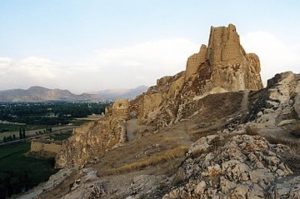
Apparently, the inaccessible position of Van Rock was the reason why the country’s capital, Tushpa, was founded here.
The fort was so well defended that no Assyrian army was able to capture it.
Eight different rock-cut structures are made in the rock of Van.
To the south-west of the cliff are the famous Khorkhorian Caves (“Argishti’s First Rooms”), which consist of two large rock-cut interconnected complexes, a smaller cave overlooking the turbulent shores of Lake Van. There is an empty niche near this cave – eight of the cuneiform columns of the Khorkhorian chronicle.
Next is the largest Khorkhoryan cave, the entrance of which is bordered by the mentioned inscription “…
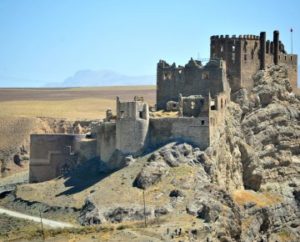
“Almost all Urartian castles and fortresses are built on easily defensible sites, usually on hills, which themselves, due to their geographical features, were strategically important. But not only castles and palaces were built in impregnable places. Inaccessible locations were often chosen for the construction of tombs.
Despite the descending staircase, the tombs on the rock of Van were difficult to reach if one tried to approach them from the foot. The entrance to Kayal’s role was at an inaccessible height.
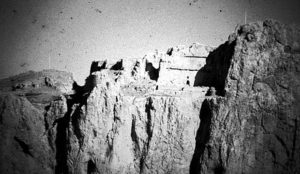
Mausoleum complex in Van Mesnaberd (1973 photo)
The entrances to the tombs, as we saw, were tightly closed.
The tombs themselves were often carefully hidden, particularly in Altin-Tepe, at least for that purpose, superstructures were built on the tombs. ”
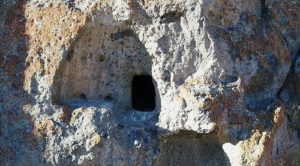
“La mort ne connaît ni frontières géographiques, ni chronologiques, ni ethniques et sociales. Ce phénomène mystérieux a toujours fait l’objet de réflexions de la part des philosophes et des théologiens.
Il existe de nombreuses preuves que dans les sociétés préhistoriques, il y avait des perceptions de la mort certaines et parfois différentes. qui ont eu un certain impact sur la vie culturelle de la société.
Dans presque toutes les théories religieuses, la mort n’est pas considérée comme une fin complète de l’existence. On suppose qu’il y a une vie après la mort, une existence continue de l’âme ou de l’être humain. En fait, il y a une tendance à nier complètement l’existence de la mort.
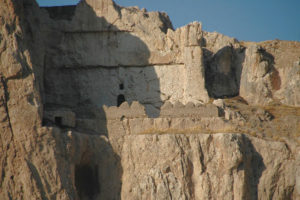
Et c’est une des raisons pour lesquelles une personne cherche à perpétuer ou prolonger la mémoire de soi à travers certaines activités, notamment, en construisant des monuments immenses et magnifiques. »
D’après les paroles de Monte, actuelles aujourd’hui, sur la page ci-dessous…
karineavetisyan.am/archives/3383:
Héros national d’Arménie et de la République d’Artsakh Monte Melkonian :
